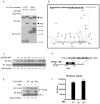Negative feedback in noncanonical NF-kappaB signaling modulates NIK stability through IKKalpha-mediated phosphorylation
- PMID: 20501937
- PMCID: PMC2913610
- DOI: 10.1126/scisignal.2000778
Negative feedback in noncanonical NF-kappaB signaling modulates NIK stability through IKKalpha-mediated phosphorylation
Abstract
Canonical and noncanonical nuclear factor kappaB (NF-kappaB) signaling are the two basic pathways responsible for the release of NF-kappaB dimers from their inhibitors. Enhanced NF-kappaB signaling leads to inflammatory and proliferative diseases; thus, inhibitory pathways that limit its activity are critical. Whereas multiple negative feedback mechanisms control canonical NF-kappaB signaling, none has been identified for the noncanonical pathway. Here, we describe a mechanism of negative feedback control of noncanonical NF-kappaB signaling that attenuated the stabilization of NF-kappaB-inducing kinase (NIK), the central regulatory kinase of the noncanonical pathway, induced by B cell-activating factor receptor (BAFF-R) and lymphotoxin beta receptor (LTbetaR). Inhibitor of kappaB (IkappaB) kinase alpha (IKKalpha) was previously thought to lie downstream of NIK in the noncanonical NF-kappaB pathway; we showed that phosphorylation of NIK by IKKalpha destabilized NIK. In the absence of IKKalpha-mediated negative feedback, the abundance of NIK increased after receptor ligation. A form of NIK with mutations in the IKKalpha-targeted serine residues was more stable than wild-type NIK and resulted in increased noncanonical NF-kappaB signaling. Thus, in addition to the regulation of the basal abundance of NIK in unstimulated cells by a complex containing tumor necrosis factor receptor-associated factor (TRAF) and cellular inhibitor of apoptosis (cIAP) proteins, IKKalpha-dependent destabilization of NIK prevents the uncontrolled activity of the noncanonical NF-kappaB pathway after receptor ligation.
Conflict of interest statement
Figures





Comment in
-
Controlling the fate of NIK: a central stage in noncanonical NF-kappaB signaling.Sci Signal. 2010 May 25;3(123):pe18. doi: 10.1126/scisignal.3123pe18. Sci Signal. 2010. PMID: 20501935 Free PMC article.
Similar articles
-
Essential role of nuclear factor (NF)-kappaB-inducing kinase and inhibitor of kappaB (IkappaB) kinase alpha in NF-kappaB activation through lymphotoxin beta receptor, but not through tumor necrosis factor receptor I.J Exp Med. 2001 Mar 5;193(5):631-6. doi: 10.1084/jem.193.5.631. J Exp Med. 2001. PMID: 11238593 Free PMC article.
-
Maximal adamantyl-substituted retinoid-related molecule-induced apoptosis requires NF-κB noncanonical and canonical pathway activation.Cell Death Differ. 2011 Jan;18(1):164-73. doi: 10.1038/cdd.2010.84. Epub 2010 Jul 30. Cell Death Differ. 2011. PMID: 20671747 Free PMC article.
-
Constitutive BR3 receptor signaling in diffuse, large B-cell lymphomas stabilizes nuclear factor-κB-inducing kinase while activating both canonical and alternative nuclear factor-κB pathways.Blood. 2011 Jan 6;117(1):200-10. doi: 10.1182/blood-2010-06-290437. Epub 2010 Oct 1. Blood. 2011. PMID: 20889926 Free PMC article.
-
Non-canonical NF-κB signaling pathway.Cell Res. 2011 Jan;21(1):71-85. doi: 10.1038/cr.2010.177. Epub 2010 Dec 21. Cell Res. 2011. PMID: 21173796 Free PMC article. Review.
-
The noncanonical NF-κB pathway.Immunol Rev. 2012 Mar;246(1):125-40. doi: 10.1111/j.1600-065X.2011.01088.x. Immunol Rev. 2012. PMID: 22435551 Free PMC article. Review.
Cited by
-
NIK regulates MT1-MMP activity and promotes glioma cell invasion independently of the canonical NF-κB pathway.Oncogenesis. 2016 Jun 6;5(6):e231. doi: 10.1038/oncsis.2016.39. Oncogenesis. 2016. PMID: 27270613 Free PMC article.
-
TRAF3 loss-of-function reveals the noncanonical NF-κB pathway as a therapeutic target in diffuse large B cell lymphoma.Proc Natl Acad Sci U S A. 2024 Apr 30;121(18):e2320421121. doi: 10.1073/pnas.2320421121. Epub 2024 Apr 25. Proc Natl Acad Sci U S A. 2024. PMID: 38662551 Free PMC article.
-
Controlling the fate of NIK: a central stage in noncanonical NF-kappaB signaling.Sci Signal. 2010 May 25;3(123):pe18. doi: 10.1126/scisignal.3123pe18. Sci Signal. 2010. PMID: 20501935 Free PMC article.
-
Targeting NF-κB-Inducing Kinase (NIK) in Immunity, Inflammation, and Cancer.Int J Mol Sci. 2020 Nov 11;21(22):8470. doi: 10.3390/ijms21228470. Int J Mol Sci. 2020. PMID: 33187137 Free PMC article. Review.
-
Context-specific BAFF-R signaling by the NF-κB and PI3K pathways.Cell Rep. 2013 Nov 27;5(4):1022-35. doi: 10.1016/j.celrep.2013.10.022. Epub 2013 Nov 14. Cell Rep. 2013. PMID: 24239354 Free PMC article.
References
-
- Baeuerle PA, Baltimore D. NF-κB: Ten years after. Cell. 1996;87:13–20. - PubMed
-
- Bonizzi G, Karin M. The two NF-κB activation pathways and their role in innate and adaptive immunity. Trends Immunol. 2004;25:280–288. - PubMed
-
- Matsushima A, Kaisho T, Rennert PD, Nakano H, Kurosawa K, Uchida D, Takeda K, Akira S, Matsumoto M. Essential role of nuclear factor (NF)-κB–inducing kinase and inhibitor of κB (IκB) kinase α in NF-κB activation through lymphotoxin β receptor, but not through tumor necrosis factor receptor I. J Exp Med. 2001;193:631–636. - PMC - PubMed
-
- Claudio E, Brown K, Park S, Wang H, Siebenlist U. BAFF-induced NEMO-independent processing of NF-κB2 in maturing B cells. Nat Immunol. 2002;3:958–965. - PubMed
Publication types
MeSH terms
Substances
Grants and funding
LinkOut - more resources
Full Text Sources
Molecular Biology Databases
Miscellaneous

